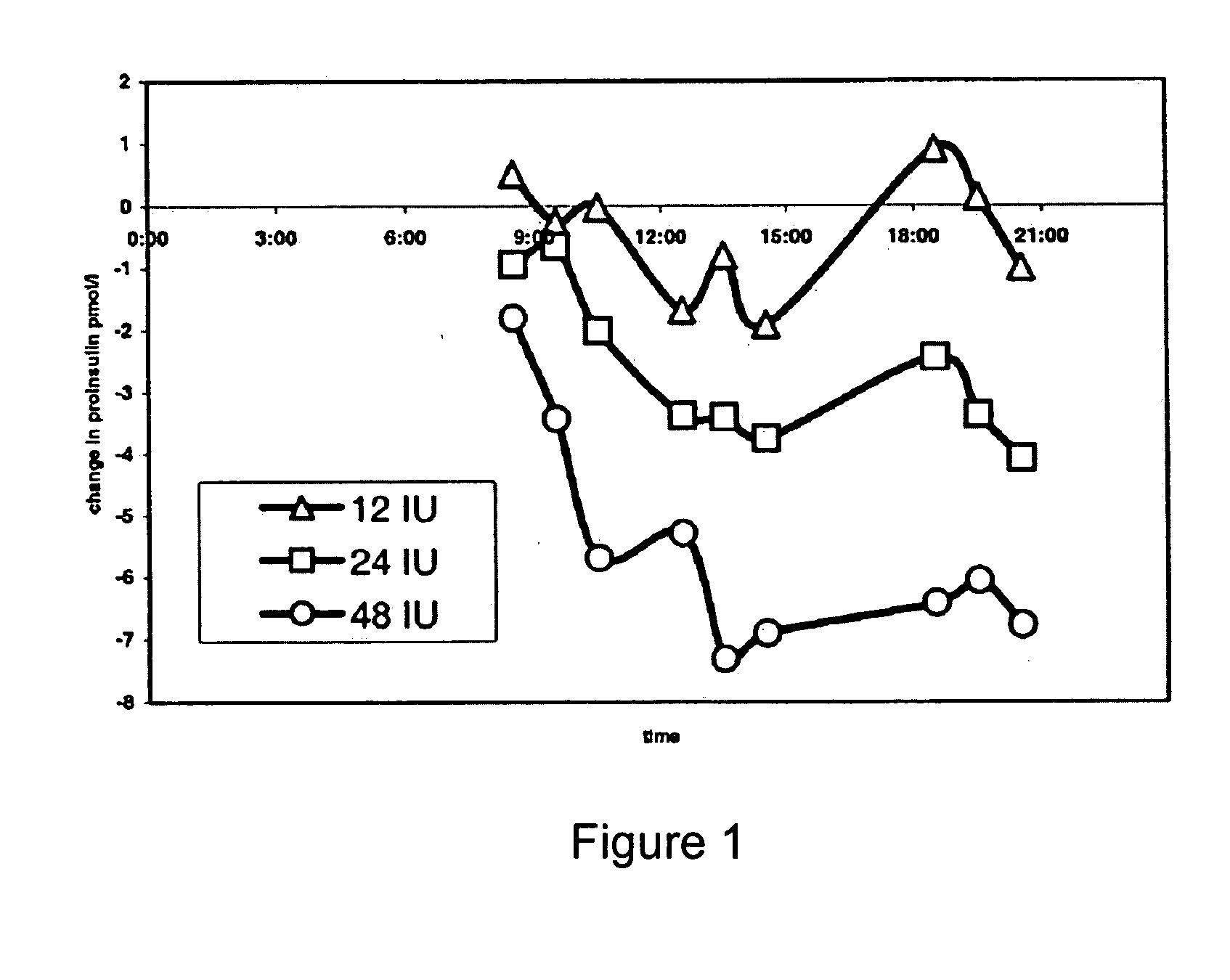Method of reducing serum proinsulin levels in type 2 diabetics
a type 2 diabetic and serum proinsulin technology, applied in the field of diabetes mellitus and related sequelae, can solve the problems of a 2 to 4 times greater risk of stroke and heart attack, and achieve the effects of reducing post-prandial pancreatic stress, reducing risk factors for atherosclerosis, and reducing serum proinsulin levels
- Summary
- Abstract
- Description
- Claims
- Application Information
AI Technical Summary
Benefits of technology
Problems solved by technology
Method used
Image
Examples
example 1
Pulmonary Delivery of Technosphere® / Insulin to Rats Results in Rapid Absorption
[0021] The pharmacokinetic (PK) profile of pulmonary Technosphere® / insulin particles administered as a dry powder aerosol was compared to the PK profile of human insulin delivered by subcutaneous (s.c.) injection in the rat. A flow-past, nose-only inhalation exposure system was used to administer the aerosols. In the first experiment, all animals received the same formulation (9.1% insulin) but the duration of dosing was adjusted to deliver doses of approximately 1 IU and 3 IU per rat (200 g body weight). A linear dose-dependent response was observed: the maximal serum insulin concentration (CMAX) was 76±12 μIU / mL after a 0.9 IU dose of Technosphere® / insulin and 240±49 μIU / mL after a 2.7 IU dose. The maximum serum insulin levels were obtained in samples taken immediately after the dosing was completed, indicating rapid absorption of Technosphere® / insulin into the systemic circulation. The time to CMAX (T...
example 2
Technosphere® Fumaryl Diketopiperazine Particles Facilitate the Absorption of Insulin in a Primary Cell Culture Model of Alveolar Epithelium without Evidence of Cytotoxicity
[0024] To investigate the mechanism by which Technosphere® / Insulin product crosses the epithelial barrier of the deep lung, experiments were conducted using monolayers of rat alveolar epithelium in primary culture. Alveolar type II cells were isolated and cultured on semi-permeable polycarbonate membranes until tight monolayers with high trans-epithelial electrical resistance (TEER) were formed. Insulin transport experiments with the Technosphere® / Insulin product and an un-formulated insulin control were then conducted across these monolayers in the apical to basolateral direction at 37° C. Insulin demonstrated an apparent permeability (Papp) of 1.90±0.34×10−8 cm / s, while the Technosphere® / Insulin product demonstrated a Papp that was ten-fold higher at 2.08±0.82×10−7 cm / s. The TEER did not change appreciably bet...
example 3
Treatment of Humans with Pulmonary Insulin Reduces Serum Proinsulin Levels
[0025] Inhalation of Technosphere® / Insulin (TI) provides a rise in serum insulin, comparable to the first phase response. This study investigated the pharmacodynamics of TI and its impact on intact proinsulin release, iPi release. Twenty-four patients with Type 2 diabetes received doses of Technosphere® base with 4 different loadings of insulin, either 0, 12 IU, 24 IU or 48 IU of recombinant regular human insulin, five minutes after start of standardized meals, on separate study days. Blood glucose (BG), serum insulin and serum iPi were measured before (0 min), 60 and 120 min after initiation of each meal.
[0026] TI lowered postprandial BG levels in a dose-dependent manner. Sixty minutes after lunch, BG (mg / dl) (±SD) was 183.2 (±44.4) for placebo; 170.8 (±30.5) for 12 IU (p=0.266); 156.3 (±31.9) for 24 IU, (p=0.020) and 132.6 (±29.1) for 48 IU, (p<0.001). All doses caused an increase in serum insulin at 60 mi...
PUM
| Property | Measurement | Unit |
|---|---|---|
| Time | aaaaa | aaaaa |
| Time | aaaaa | aaaaa |
| Particle size | aaaaa | aaaaa |
Abstract
Description
Claims
Application Information
 Login to View More
Login to View More - R&D
- Intellectual Property
- Life Sciences
- Materials
- Tech Scout
- Unparalleled Data Quality
- Higher Quality Content
- 60% Fewer Hallucinations
Browse by: Latest US Patents, China's latest patents, Technical Efficacy Thesaurus, Application Domain, Technology Topic, Popular Technical Reports.
© 2025 PatSnap. All rights reserved.Legal|Privacy policy|Modern Slavery Act Transparency Statement|Sitemap|About US| Contact US: help@patsnap.com

